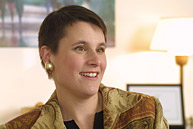Entre nous: How advisory committees work
Entre nous: How advisory committees work McGill University
User Tools (skip):
How advisory committees work
Secretary-General Robin Geller
The advisory committee business is booming at McGill. Seven advisory committees are currently in session, searching for the leaders of a half dozen faculties as well as a vice-principal of research and international relations. Providing support to the work of the advisory committees is Robin Geller, McGill's Secretary-General, responsible for the Secretariat along with her team of Mary Shaw and Cheryl Karasick. Geller, who will be leaving the university in mid-February, recently talked about the role and function of advisory committees and the impact of their work on the future of the university.

Secretary General Robin Geller
Owen Egan
Why are advisory committees important to McGill?
Advisory committees provide critically important advice to the Principal and Provost on the selection of the future leaders of the institution at all levels. Under the McGill Statutes, advisory committees are required for the selection of the Principal, Vice- Principals and Deans. There are few processes that are more important to the future of McGill than when advisory committees are selecting Deans for Engineering, Science (concluded at Monday's Board meeting with the appointment of a new Dean, see front page story), Management, Medicine, Dent-istry, and Agricultural and Environmental Sciences as well as an advisory committee for a Vice-Principal (research and international relations). We normally start an advisory committee a year before the mandate of the incumbent ends and there are another four deans whose current terms come to an end in June 2006 — so we will be launching four more decanal advisory committees. This is a critical juncture in shaping the university's future.
Who sits on an advisory committee?
The composition of advisory committees depends on whose selection is under consideration (Principal, Vice-Principal or Dean). The statutory advisory committees have a mandated composition that includes members appointed by the Board of Governors and Senate, as well as faculty and students. The specific composition of different advisory committees is set out in the University Statutes (www.mc-gill.ca/secretariat/documents). For example, for the Dean of a large faculty, the statutes require an advisory committee of thirteen members, consisting of four members nominated by the faculty immediately concerned, four members not necessarily members of the faculty concerned, nor of Senate, appointed by Senate, two members appointed by the Board of Governors, and three student members.
Can you give us an idea of the advisory committee process?
It starts with a general meeting of the advisory committee where the parameters are set. The committee discusses whether it will be considering the possibility of a reappointment. The committee will usually develop a position profile and review the requirement of confidentiality. The committee will also decide whether or not a consultant firm is needed and whom the committee would like to hear from to shed light on the issues that need to be taken into account. If a reappointment is being considered, they will likely solicit input from a range of individuals that the incumbent has interacted with over the course of his or her term. For a new appointment, the committee will develop a position profile based on their deliberations and discussions. That will normally launch the advertising phase of a search. Depending on the position, ads will be placed in a variety of publications and nominations and submissions are invited. A short list of candidates is interviewed and the committee reaches a consensus to recommend the top two or three candidates to the Principal. In the case of decanal searches, where the Provost chairs the advisory committee, the Principal would normally meet with the top candidates and reach a final conclusion.
Is that the end of the process?
Negotiations with the candidate begin, all of which are subject to final approval by the Board. Typically, from start to finish, for a new appointment, the process can take from four to twelve months.
Can anyone in the university community become involved in the advisory committee process?
Yes. Anyone interested in sitting on an advisory committee in their own faculty should speak to their dean. If it is not their own faculty, they should make their interest known to the Senate nominating committee. We're always wishing to engage individuals who can make a meaningful contribution and who will be active and engaged members of an advisory committee. There are other avenues for involvement as well. During the advisory committee process, ads are placed in campus publications (like The Reporter) to invite the community to forward candidates' names and also provide more general input about the needs of the position. This is a great opportunity. We typically don't receive as much feedback from those notices as we would like. People should recognize that this kind of input is reviewed very carefully by the committees and is very valuable to them in doing their work. When we publish the names of the members of the advisory committees, people should also know that they can approach members with their thoughts and viewpoints. Input doesn't have to be formal or written or bureaucratic. What we want is to ascertain the views of faculty, students and staff on the selection process.
